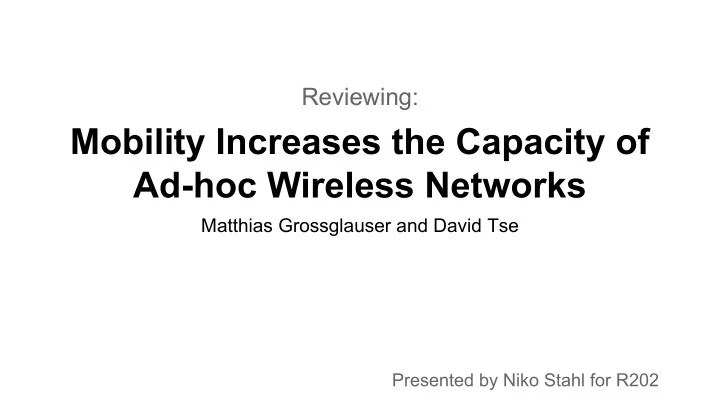

Reviewing: Mobility Increases the Capacity of Ad-hoc Wireless Networks Matthias Grossglauser and David Tse Presented by Niko Stahl for R202
Context capacity of an ad-hoc wireless network
Context capacity of an ad-hoc wireless network ● ad-hoc => does not rely on existing infrastructure such as access points ● routing is decentralized: each nodes participates in the routing by forwarding data ● routing decisions are made dynamically depending on the network connectivity (changing network topology)
Context capacity of an ad-hoc wireless network Capacity is measured in terms of total throughput (Mbit/s)
Context The paper’s result apply to delay-tolerant networks . Examples: email, database synchronization, networks in space (where network topology changes frequently) Non-Examples: any real-time application (e.g. voice communications)
Problem What is the theoretical capacity of an ad-hoc, mobile, delay-tolerant network ? How does it compare to the capacity of a stationary network?
Model - Overview What’s the scenario? ● n … number of mobile nodes ● trajectory as a stationary and ergodic process ● trajectories of different nodes are i.d.d. (independent and identically distributed)
Model - Session Model ● Each source has infinite number of packets to send its destination
Model - Transmission Model ● X i (t) … position of node i at time t ● beta … signal-to-interference ratio (SIR) ● P i (t) … transmit power of node i at time t ● gamma ij … channel gain from node i to j ● alpha … constant for signal decay (~2) ● P i (t)*gamma ij … received power at node j ● Transmission between nodes i and j at time t is possible, if
Model - Transmission Model The gist of it: Transmission between two nodes (i,j) depends on 1. how close they are to each other 2. the interference from other nodes
Model - The Scheduler At time t, the scheduler decides 1. whether/to whom nodes will send packets 2. the power levels of those senders The sender’s objective: Maximize long-term throughput for each S-D pair.
Result - Fixed Nodes ● Gupta and Kumar (2000), “The Capacity of Wireless Networks” ● Nodes are randomly located, but immobile ● Source & destination nodes selected at random ● Their main result: As n, number of nodes per unit area, increases the throughput per S-D pair decreases with complexity
Result - Fixed Nodes ● Reason: More nodes => more hops. Therefore, each nodes needs to dedicate more of its capacity to relaying packets travelling to other nodes.
Result - Fixed vs. Mobile Nodes ● Mobile nodes are expected to meet eventually (and we are tolerating delay). ● Can we improve the capacity of the network without any relaying?
Result - Fixed vs. Mobile Nodes ● Mobile nodes are expected to meet eventually (and we are tolerating delay). ● Can we improve the capacity of the network without any relaying? ● No , most of the time the distance between source and destination is large and simultaneous long- range communication is limited by interference. ● Throughput per S-D pair goes to zero as
Result - Mobile Nodes with Relaying ● Goal : Spread packets to intermediate nodes to increase the chance of short range hops between source and destination. ● Question : How many times does a packet have to be relayed to maximize throughput?
Result - Mobile Nodes with Relaying Sender Policy Goal: Dispersion of Packets ● Randomly partition nodes into senders (S) and receivers (R) ● Each sender transmits packets to its nearest neighbor in R. As a function of n, the number of pairs where the interference generated by others is sufficiently small to transmit successfully is O (n) (see Theorem 3.4)
Result - Mobile Nodes with Relaying Algorithm (packet-view):
Result - Mobile Nodes with Relaying Algorithm (overview):
Result - Mobile Nodes with Relaying Analysis of Algorithm: ● The probability that two nodes i,j are selected as feasible by the sender policy is O(1/n) (Theorem 3.4) ● Summing over the n-2 two-hop routes and the 1 direct route, the total average throughput per S-D pair is O(1) (see theorem 3.5). This is the paper’s main result .
Revisiting Assumptions ● Stationary and ergodic mobility (this is a simple type of mobility) ○ stationary => statistical properties constant over time ○ ergodic => “ In practice this means that statistical sampling can be performed at one instant across a group of identical processes or sampled over time on a single process with no change in the measured result.” - Wikipedia ● Mobility of nodes is independent ● Each node has infinite buffer ● Extreme delay tolerance. Focus is on throughput.
Conclusion I - Quantitative Throughput per S-D pair in network with n nodes: Fixed (Gupta and Mobile No Relay Mobile Single Hop Kumar (2000)) Relay
Conclusion II - Qualitative ● A single, random relay node is sufficient to yield constant throughput as the number of nodes increases. ● There’s a tradeoff between between throughput and delay in mobile wireless networks.
Questions & Criticism ● This is an extreme view of the tradeoff between delay and throughput. ● Is there an upper bound on the delay of communications between two nodes? “Throughput-Delay Trade-off in Wireless Networks” (Gamal et al., 2004)
Recommend
More recommend